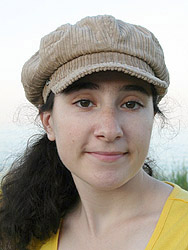
|
|
February 12th, 2009
View Larger Map
Addresses and Information:
Airport:
ATL (25-30 Minute Cab Ride to MIDTOWN Atlanta, COST = $35).
Hotel:
W Hotel – Midtown Atlanta [link]
188 14th St NE,
Atlanta, GA 30361
(404) 892-6000
Reception (Friday 2/20/2009)
2655 Canna Ridge Circle NE
Atlanta, GA 30345,
770 414 8816
Meeting Venue (Saturday 2/21/2009 and Sunday 2/21/2009)
Georgia Tech
Klaus Advanced Computer Building,
266 Ferst Drive
Atlanta, GA 30332-0765 [directions]
Shuttle from Hotel to Meeting Venue will be PROVIDED
Dinner (Saturday 2/21/2009)
Trois [link] (walking distance from Hotel)
1180 Peachtree St NE
Atlanta, GA 30309,
(404) 815-3337)
Dinner (Sunday 2/22/2009)
Spice Market [link] (in the Hotel)
188 14th St NE, Atlanta,
GA 30309,
(404) 549-5450)
Tags: ACs
Posted in AC | No Comments »
February 4th, 2009
CVPR Area Chair Meeting
February 21-22, 2009
Meeting Location:
Georgia Tech
Klaus Advanced Computer Building (KACB),
266 Ferst Drive
Atlanta, GA 30332-0765 [directions]
Hotel:
W Hotel – Midtown Atlanta [link]
188 14th St NE,
Atlanta, GA 30361
(404) 892-6000
Room Locations:
PLENARY SESSIONS / FOOD: KACB 1116 E&W
PANEL 1: KACB 1202
PANEL 2: KACB 1212
PANEL 3: KACB 1215
PANEL 4: KACB 2100
SCHEDULE
- 2/20/09 (Friday)
- ACs Arrive
- 3:00 PM - 6:00 PM Program Chairs Meeting (TSRB 230A)
- 6:30 PM Reception at Irfan/Shanila Essa’s Home (2655 Canna Ridge Circle NE, Atlanta, GA 30345, 770 414 8816)
- drinks and hors d’oeuvres
- directions will be provided (15-20mins from hotel)
- group departure at 6:30p
- Late Arrivals can take a CAB from the Hotel to the Reception (Maps will be at Front Desk).
- 2/21/09 (Saturday)
- 8:00 AM: Board shuttle bus at hotel (5 minute ride to campus)
- 8:30 AM: Breakfast
- 9:00 AM - 10:00 AM: PLENARY: Introductions of the AC. Agenda Setting for the Rest of the AC Meeting by PC Chairs.
- 10:00 AM - 12:00 Noon: BUDDIES: AC Buddy Pairs to Work Together: Make Decisions on Each Other’s Assigned Paper
- 12:00 noon - 1pm: BUDDIES: Working Lunch with Buddies
- 1:00 PM - 1:30 pm: PLENARY: To check on Status and Address Concerns
- 1:30 PM - 3:30 pm: BUDDIES: AC Buddy Pairs to Continue Working
- 3:30 PM - 4:00 pm: PANELS: To get updates from Buddy Pairs and Discuss Problems as needed
- 4:00 PM - 5:30 pm: BUDDIES:AC Buddy Pairs to Continue Working
- 5:30 PM - 6:00 pm: PLENARY: To check on Status and Address Concerns
- 6:00 PM - 6:30 PM: BUDDIES: AC Buddy Pairs to Continue Working
- 6:30 PM: Shuttle to Hotel
- 7:30 PM: Dinner at Trois [link]
- walking distance from Hotel:
- 1180 Peachtree St NE # A Atlanta, GA 30309, (404) 815-3337
- 2/22/09 (Sunday)
- 8:00 AM: Board shuttle bus
- 8:30 AM: Breakfast
- 9:00 AM - 9:30AM: PLENARY: Setting Agenda for the DAY. Tasks assigned.
- 9:30 AM - 11:30 AM: PANELS
- 11:30 AM - 12:00 N: BUDDIES: Buddies to work on open issues.
- 12:00 Noon - 1:00 PM: BUDDIES: Working Lunch
- 1:00 PM - 2:30 PM: PLENARY
- 2:30 PM - 4:30 PM: PANELS
- 4:30 PM - 5:00 PM: PLENARY (to close the MEETING)
- 5:00 PM - 6:00 PM: PLENARY: TOWN HALL to give feedback to Current and Future Program Chairs
- 6:30 PM: Shuttle to Hotel
- 7:30 PM: Dinner at Spice Market [link]
- in the Hotel
- 188 14th St NE, Atlanta, GA 30309, (404) 549-5450
- 2/23/09 (Monday)
- 9:00 AM - 4:00 PM: AC Workshop, including tours to GVU and RIM Centers
Tags: ACs
Posted in AC | No Comments »
February 4th, 2009
Continuing a time-honored CVPR tradition, we cordially invite you to join us on Monday Feb 23, the day after the AC Meeting, for the AC Vision Workshop, held on the Georgia Tech campus.
Location: Klaus Advanced Computing Building 1116
We look forward to seeing you in Atlanta!
Schedule:
| 8:55 |
Opening
|
| 9:00
|
Visual Category Recognition and People Detection
D. Bernt Schiele
Professor in Computer Science, TU Darmstadt |
| 9:25
|
Semi-supervised Learning in Vision
Dr. Horst Bischof,
Professor at the Institute for Computer Graphics and Vision at the Technical University Graz, Austria |
| 9:50
|
Curious George: A Visually-guided Autonomous, Adaptive Home Robot
Dr. Jim Little
Professor in the Department of Computer Science at the University of British Columbia |
| 10:15
|
People and Objects with a Purpose:Functional Recognition in Persistent Video
Dr. Anthony Hoogs
Director of Computer Vision at Kitware, Inc. |
| 10:40 |
Coffee Break
|
| 11:00
|
Non-Rigid Structure From Motion: Estimating Shape and Motion With Hierarchical Priors
Dr. Aaron Hertzmann
Associate Professor at University of Toronto |
| 11:25
|
Monument Image Mining
Dr. Luc Van Gool
Professor, ETH Zurich - Department of Information Technology and Electrical Engineering - Computer Vision Laboratory |
| 11:50
|
Imaging and Restoration of Old Manuscripts
Dr. Michael S. Brown
Sung Kah Kay Assistant Professor, National University of Singapore |
| 12:15 |
Lunch
|
12:50
-
 Dr. Daniel Cremers
|
Convex Relaxation for Multiview Reconstruction
Dr. Daniel Cremers
Professor at University of Bonn |
13:15
-
 Dr. Ramesh Raskar
|
Computational Photography: From Epsilon to Coded Photography
Dr. Ramesh Raskar
Associate Professor, MIT Media Lab |
| 13:40
|
Predicting the Net Worth of Image Annotations
Dr. Kristen Grauman
Clare Boothe Luce Assistant Professor at University of Texas at Austin |
| 14:05 |
Coffee Break
|
| 14:25
Dr. Svetlana Lazebnik
|
Representing Internet Photo Collections with Iconic Images
Dr. Svetlana Lazebnik
Assistant Professor at University of North Carolina at Chapel Hill |
| 14:50
|
Things you can’t resolve
D. Yoav Y. Schechner
Professor at Technion - Israel Institute of Technology |
| 15:15
|
Radiometric Calibration using Temporal Irradiance Mixtures
Dr. Yasuyuki Matsushita
Lead Researcher at Microsoft Research Asia |
| 15:40 |
End of Workshop
|
Tags: ACs
Posted in AC | No Comments »
February 4th, 2009
AC Meeting will be held in Atlanta, GA at the GA Institute of Technology Campus, Feb 21-22 (Sat/Sun), 2009, followed by a 1 day AC workshop on Feb 23 (Mon), 2009.
Here are additional details.
- AC Meeting
- Schedule (PDF) for Feb 20-Feb 22, 2009.
- Logistics (PDF) (Maps/Direction to all places/venues and other information)
- Process Guidelines (Details of how the meeting will proceed)
- AC Arrive/Departure Info (PDF) (To meet at the CAB/Taxi stand and share rides!)
- Weather in Atlanta (Weather Underground). Plan for cooler nights, windy, and partly sunny.
- AC Workshop – Feb 23 (Mon), 2009.
- Contact Frank Dellaert for details.
Tags: ACs
Posted in AC | 1 Comment »
January 31st, 2009
Paper Info
Abstract
Time and Location Info
Posted in Technical Paper | No Comments »
January 31st, 2009
Title, author, bibtex info
Abstract
Time and Location of presentation / track info
Posted in Technical Paper | No Comments »
January 15th, 2009
FLIGHTS
Please make your flight reservations ASAP to help us keep costs down. You will fly into Atlanta Hartsfield-Jackson International Airport (code: ATL). Delta Airlines is the major carrier with flights worldwide (www.delta.com). All reservations must be COACH class only. Please follow the fare guidelines given below:
$250 East Coast USA
$350 Other USA
$450 Other North America
$750 Europe
$1200 Asia
$1600 Australia
HOTEL
You must make your own reservation at the meeting hotel below. Reference “Georgia Tech/Computer Vision and Pattern Recognition” when making your reservation, to get the discounted rate of $125/night. To get this special rate, you must make your reservation by January 21.
When your reservations are complete, please send you itinerary to Vivian Chandler (chandler@cc.gatech.edu). Please direct any questions to Jim Rehg (rehg@cc.gatech.edu).
W Hotel – Midtown Atlanta
188 14th St NE, Atlanta, GA 30361
+1 (404) 892-6000
(You can make your reservation 24 hours/day using the above number)
TRANSPORTATION
We will send detailed instructions shortly. You will not need a rental car in Atlanta, and we cannot reimburse you for one.
REIMBURSEMENT
IEEE will reimburse for one COACH class round-trip air fare, other transportation costs, and the hotel costs for the nights of Feb 20-22 at the discounted rate. All meals will be provided on 2/21 and 2/22. Other travel-related meals should be limited to $20 lunch/$40 dinner. You will send your receipts to Terry Boult, more detailed instructions will follow.
Jim Rehg, General Chair, CVPR 2009!
Tags: ACs, Information
Posted in Guidelines | No Comments »
January 14th, 2009
Once you’ve been notified that the papers have been assigned to you, please log in to the site and follow these steps:
1. Download papers and check for possible conflict or submission rule violation:
- In the “Area Chair” console, click on “Select Reviewer Candidates”.
- You can download all the papers in a ZIP file from “Download All Files”. To reduce bandwidth, we exclude the supplementary files from the ZIP file.
- Contact the program chairs immediately (cvpr09-pc-chairs@googlegroups.com) if:
- You think you are in any way conflicted with the paper.
- There is a violation of the stated paper submission rules.
- Such a violation include:
- Not anonymous (names listed on front page),
- Over 8 pages,
- Is double submission,
- Supplementary material includes newer version of the paper.
- Please specify the exact nature of the violation.
2. Familiarize yourself with “Select Reviewer Candidates” page (part of it shown below):

- “Paper Summary” label: next to it, you’ll see the icons ”+” and ”-”. Clicking on ”+” shows you all the abstracts; clicking on “-” collapses all them back.
- At the end of each paper title, you’ll see “+” as well. This has the same function of showing the abstract for that paper, toggling to “-” at the same time, which collapses it when selected.
- If you prefer to download the supplementary files, you’ll have to download them on a per-paper basis (under “Download Files”).
3. Add reviewer suggestions. For each paper, click on “Change Suggestions”. In the “Edit Candidates” page (part of it shown below):

- The reviewers are initially listed based on “Reviewer Relevance”. This number is computed based on matches on Primary and Secondary Subject Areas.
- Please take the time to familiarize yourself with the table entries:
* Left-most column allows you to add the current reviewer to your list of suggestions.
* Pick at least 5 people, making sure not more than two people are from the same organization. This will increase your chances of getting your selections. Note that we list ALL reviewers, regardless of whether there’s conflict with the paper. We do this to discourage speculation on authorship.
* Please bear in mind that “Researcher/Faculty” has a limit of 12 papers to review while “Graduate Student” has a limit of 5.
* Clicking on any of the column heading sorts according to its description.
- You can filter the reviewers. Here are two examples:

* Filter example 1 (you are only interested in looking at reviewers whose relevance is at least 0.25): Click on “Add Filter Condition”, from left to right, select “Relevance” and “>=”, and type in “0.25″. Then click on “Find Reviewers”.
* Filter example 2 (you are only interested in reviewers who are “Researcher/Faculty”): Click on “Add Filter Condition”, from left to right, select “Reviewer Type”, “=”, and “Researcher/Faculty”. Then click on “Find Reviewers”.
* You can pipe multiple filters together (say, adding the first condition, then adding the second condition using “Add Filter Condition”).
* If you have mistakenly clicked on “Add Filter Condition” and created a placeholder for a filter condition, click on the leftmost “X” icon to remove it.
- The higher the reviewer is ranked, the higher the weight assigned to him/her during the paper-to-reviewer assignment process. You can re-order a reviewer by clicking on “Move Up” or “Move Down” next it the name.
- Don’t forget to click on the “Save Changes” button to submit any changes you’ve made.
4. (Optional) Add a new reviewer (in “Edit Candidates” page):

- This should be done sparingly. There is usually a good reason why the person you are looking for is not in the reviewer list.
- Double-check your spelling when doing your search to make sure that person is really not in the list.
- Click on the “Add New Reviewer” button (arrowed above). Please read the instructions in the ”Add New Reviewer” page. In this page, you will be asked to first supply the email of the new reviewer. The system checks if that person is already a reviewer based on the email address.
- If that person is already a reviewer, you will be asked to go back to the previous page to add this person through the reviewer list.
- If that person already has an account but is not a reviewer, you need to supply reviewer type, conflict domain(s), and subject area(s). If that person does not have an account, you will need to supply the contact information as well. We assume you must know this person reasonably well to specifically request for him/her. (CMT will issue the invitation anonymously on your behalf. If that person later agrees to review, he/she will have the opportunity to edit reviewer information.)
- Once you have completed the request, that person will be added to the reviewer list. You will need to return to the reviewer list and add this new reviewer in.
- We will follow up with the newly added reviewers to ensure that they agree within a few days of the request, as we cannot allow too long of a period for such reviewer decisions to be made. We will notify you if any invitation to review is declined (you will then have to select someone else).
- We will be disabling the “Add New Reviewer” feature after Dec. 8 5PM PST (Dec. 9 1AM GMT).
5. Still need help?
Tags: Reviewing
Posted in Guidelines, Reviewing | No Comments »
November 1st, 2008
During the reviewing phase (Nov 22, 2009 - Feb 30, 2009), please periodically log in to the CMT site and monitor the review progress.
Phases:
- Dec 1 - Dec 15, 2008: Phase 1: Assigning Reviewers.
- Jan 1 - Jan 29, 2009: Phase 2: Check Incoming reviews, follow up with reviewers.
- Jan 29 - Feb 5, 2009: Phase 3: Initiate discussions with reviewers, Write Draft Consolidation Reports.
- Feb 6 - Feb 13, 2009: Phase 4: Rebuttal Period. Grade Reviewers
- Feb 13 - Feb 17, 2009: Phase 5: Review Author Feedback and Discuss with Reviewers
- Feb 13 - Feb 20, 2009: Phase 6: Prepare for AC Meeting. Discuss with AC buddies, Propose decisions on paper.
- Feb 21 - Fen 22, 2009: Phase 7: AC Meeting
- NEED HELP
Phase 2. Jan 1 to review deadline (5PM PST Jan. 29, 2009, Thursday): Check incoming reviews
- In “Area Chair” console, select “Consolidation Reports”.
- You should be able to see all the reviewers’ names and the review status right next to each. For this incarnation of CMT, we just highlight cases where reviews have not been submitted (in red).
- For each paper, you can:
* View all the reviews (”View All”).
* Grade the reviews (”Rate Reviewers”).
* Email the reviewers anonymously via CMT (”Email Reviewers”). You can select all the assigned reviewers for that paper (default), or just those not done with reviewing, or specific reviewer(s). For the last item, you will be able to edit the recipient list. Remember: Don’t identify yourself or the other reviewers in the email!
- You can also choose to bulk email all reviewers or all reviewers who have not completed their reviews (for all the papers in your stack). See below the title “Consolidation Reports” (”Email Reviewer”). Mouse over the “Email Reviewer” box and you will see the two options (mentioned earlier) from which to choose.
- You can view all reviews for all papers in a single webpage. Just select “View All Reviews” in the line right below the title “Consolidation Reports”.
- Important note on emailing via CMT: Since any email sent on your behalf is anonymously sent through CMT, the communication is one way only. Please tell your email recipients to not respond to the email, because there is no automatic routing of email to you; responses go directly to the CMT admin people. The CMT folks are handling a number of conferences at any given time and will not have the resources to forward such emails. So, be very specific about what you would like the reviewer(s) to do.
- It is the area chair’s responsibility to contact and urge the reviewers to finish in a timely manner.
Phase 3. Between review deadline and 5PM PST Feb. 5, 2009, Thursday: Initiate Discussions with Reviewers.
Right after the review deadline, please look through ALL the reviews. Please let us know who have yet to finish their reviews, and we will contact them directly.
If any review appears unreasonable (e.g., one-liner comments or overly harsh), please contact the reviewer and ask for clarification. Remember that communication is only one-way, so be specific about what you need from the reviewer. Check again in one or two days to see if there is any update to that review. Since we will not be keeping track of your emails (sorry!), please do the book-keeping yourself (best to make a note of what you’ve done).
3.1 When to Initiate a Discussion
We urge you to start a discussion any time you feel that the overall scores and/or the comments are insufficient to allow you to make a decision (e.g., all “Borderline”s). At the very least, initiate a discussion if the difference between the maximum and minimum scores is greater than 2 levels.
3.2 During the Discussion
You play the role of a moderator in the discussion. While it is ideal to reach a consensus, don’t feel obligated to force one—the discussions are mainly to allow you to make more informed decisions. It is ok if the reviewers end up not changing their overall scores as long as you’ve gained a better understanding of how they arrived at their scores.
Stick to the facts, and do not influence the outcome of the discussion by imposing your views on the paper. However, if you disagree with the majority view, say so, provide compelling reasons, and solicit feedback from the reviewers.
If the discussion looks like it is getting out of hand (e.g., when a reviewer makes inappropriate remarks or a battle of words erupts), please contact us (cvpr09-pc-chairs@googlegroups.com) immediately. Don’t forget to let us know the paper number.
For cases of “Borderline”s, if the discussion appears to not head towards any decision, we suggest you ask the question “If you had to choose now, would you accept or reject this paper?”
3.3 Anonymous Discussion Feature
This feature can be accessed from the “Consolidation Reports” page:
- You must do the following steps to enable the reviewers to participate in the discussion. Emailing the reviewers via CMT is NOT the right step to initiate the discussion. Reviewers can already see the other reviews for their papers.
- To initiate a discussion for a specific paper, select “View/Post Message” under the “Consolidation Report” column for that paper.
- In the “Paper Discussion” page, click on “Start A New Topic” to initiate the discussion (unless a reviewer took the initiative of starting one, in which case you reply; see next bullet item). We suggest that your first post starts with a very brief summary of the reviews, a request for them to look at the other reviews for details, followed by specific things you want the reviewers to address.
- Once a discussion has been initiated, click on “Reply” on the far right to continue posting on the same discussion thread.
- Please sign your posts as “Area Chair”, and identify the reviewers by the review number. Never identify yourself or other reviewers by name.
- Anytime a post is made (either by the area chair or a reviewer), the area chair and reviewers will receive an email notification from CMT with the subject that looks like “CVPR2009: New reviewer discussion posted for Paper ID XXX”. There is a link in the email you can use to join the discussion (after logging in, you will routed directly to the discussion page). Alternatively, you can just log in to CMT as usual.
- After you’ve posted, DO NOT REFRESH PAGE (e.g., by hitting F5)! This will generate another post with the exact same message!
- In the discussion, you (as AC) can see the identities of the posters. However, each reviewer will NOT know the identities of the other posters.
- NEW: The author rebuttal period is Feb 6, 2009 5pm PST - Feb 13, 2009 5pm PST. Once the author rebuttal period is over, you and the reviewers will be able to see the author rebuttal (but not before). We will be enabling discussions for a week past the rebuttal deadline, just in case reviewers have any reactions to the author rebuttals.
- Because of the frank nature of the discussions, the authors will not see them at any time. The consolidation reports will be visible to authors only after the AC meeting, when decisions are made known.
- Reviewer instructions for the discussion feature are given in Section 7 here. Note that reviewers can revise their reviews, up til the 5PM PST Feb 5 deadline.
Phase 4. Feb. 6, 2009 - Feb. 13, 2009: Rebuttal Period
Remember: Feb. 6-13 is the author rebuttal period. Reviewers are no longer allowed to modify their reviews after 5PM PST Feb. 5. Authors’ reviews will be visible to both reviewers and AC after Feb 13, 5pm EST.
4.1 Grading Reviews
ACs are expected to grade each review. This information will be used in part to help us identify exceptional reviewers for recognition during the main CVPR09 conference in Miami. Some guidelines:
- “Highly Relevant”: Reviewer is on the ball on practically everything. The score is well justified, references are given to support claims that references are deficient and/or work is not original, and the reviewer appears very knowledgeable on the topic. You feel you can totally rely on this assessment.
- “Sufficient”: The review quality is mixed, but overall reliable. There are parts of the review that appear perfectly reasonable, but there are other parts that seem a bit deficient in some ways. You feel you are satisfied with the review and the reviewer has given you an evaluation you can use to make judgement on the paper.
- “Below Average”: Reviewer does not justify scores well, makes overly general unhelpful statements, states incorrect or misleading claims, provides very terse or irrelevant remarks, or appears to be overly biased. Basically, you feel you can ignore most of this review.
Phase 5. Feb 13 - Feb 17, 2009: Review Author Feedback and Discuss with Reviewers
You should be able to see the Author Rebuttal/Feedback to the reviews.You can start a discussion using the discussion board (see Phase 3: Discussion Phase) with the reviewers of the papers, especially if the rebuttal is responding to a specific review. While, the reviews cannot be changed, you can take the input from the reviewers at this phase to help in your proposed decision and the consolidation report that you have drafted (or will!). Make sure to be clear about how the rebuttal was taken into account in the consolidation report.
Remember, all consolidation reports are considered a draft and all decisions are just proposed and will be finalized at the AC Meeting.
To See Consolidates Scores on the AC website:
To allow you to see the reviewer scores on the consolidation page, in the Area Chair “Consolidation Report” page, you can customize the page by selecting “Customize The View”->”Edit Review Columns”. Select Q2 (“Overall Rating”) and click on “OK” to see the updated table.
Phase 6. Feb 13 - Feb 20, 2009: Phase 6: Prepare for AC Meeting. Discuss with AC buddies, Propose decisions on paper.
6.1 Feb. 13-20: Working with Buddies
We have enabled the system so you can now see the papers of your buddies (your buddy is listed in the table at the end of this email). Go to “Consolidation Report” from your console and at top you will see
Show Assigned Papers | Show Buddy Papers | ..
Click on “Show Buddy Papers” and it will show all the papers that your buddy was assigned. There should not be any conflict with any of the papers your buddy has. In the buddy paper list, if you don’t see your buddy AC’s name in the page, you can verify by clicking on any of the “View” link next to “Consolidation Report”.
Now here is a bit about the process.
Our Area Chair Committee is divided into Four Panels and within each panel, each AC is paired up with another AC. This has been done in the past, so it is NOT new for the old-timers in this group. The purpose of this is to have ACs work as a pair to make sure all decisions are made with some discussion with another person and to ensure all issues are dealt with fairly and appropriately. Consider this as an opportunity for someone else to look over all your decisions and look at the reviews and the author rebuttal to ensure all was fair.
Each buddy pair will be required to
- Make Accept/Reject Decision Recommendations for each of their paper
- Of the accepted papers, make a Recommendation for at least 6 papers as an ORAL. These will be discussed in PANELs at the AC Meeting.
- Of the accepted papers, make a Recommendation for at least 1 paper as potential AWARD papers (if more than 1, we need a rank-ordered list). These will be forwarded to the Awards Committee, after some discussion within a panel.
Do note that buddies have ONLY READ access to the buddy papers. The Assigned AC is the only one who can edit consolidation report and make decision recommendation and therefore it is important that both the AC discuss these and the lead AC consolidate.
So here is what to do.
- Look at the reviews/rebuttals for each paper you have and then send a note to your AC buddy asking them to look at the papers where you would appreciate some help or at-least a look over. If you ask a specific question, like “can you see paper #XXX’s review #2 and see if you agree” OR “based on reviews of paper #YYY, I am considering a recommendation of Poster” or “paper #ZZZ is the best paper in my stack, do you agree?”
- Discuss these papers with your buddy and write your consolidation report.
- Make a recommendation of a decision on this paper and when consolidation report is done, “Check box if report is FINAL” and the PC Chairs will be informed on our consoles.
Remember, you should try to do as much of this before the AC meeting and the first part of the AC meeting will also be dedicated to finishing this phase.
Here are the buddy pairs with their EMAILs (in PDF)
6.2 Feb. 13-20: Writing Preliminary Consolidation Reports
Here is what a consolidation reports should contain.
- a summary (or highlights) of what the reviewers found in the paper that they liked/disliked
- a summary of discussions with the reviewers and your buddy (without names of course!) as the discussions influenced your evaluation.
- if a variance in reviews, explain you came to your evaluation.
- if decision is to overrule one of the reviewers, please provide as much details and also discuss with your buddy. The reviewers have looked at the paper longer then you (hopefully) so their evaluation should count and if dismissed, we need to have reasons for it.
Phase 7. Feb 21 - Feb 22, 2009: AC Meeting.
Still need help?
Tags: ACs, Reviewing
Posted in Guidelines, Reviewing | No Comments »
November 1st, 2008
This post is dedicated to provide detailed guidelines to Area Chairs of CVPR 2009 as to how the process will unfold and what are their responsibilities. Area Chairs should also see
- The Reviewer Guidelines as they have information about what is expected of reviewers, information about ethics of reviewing and best practices.
- The AC Instructions (Instructions of how to use the reviewing site)
- The AC FAQ (Some of the recently asked questions and their answers)
- Google Calendar (XML, ICAL, HTML) that you can subscribe to and see the schedule.
Role of Area Chairs.
The ACs help identify suitable reviewers, assign reviewers to papers, and evaluate the reviews as well as the authors’ responses. For CVPR09, our goal is to provide the highest quality reviews to authors and for this we hope to limit the number of papers assigned per AC to about 30-35 . This will allow each AC to play a more active role in ensuring higher quality and more timely reviews, and in initiating discussions amongst reviewers (anonymously), and in looking at authors’ responses to the reviews via the online rebuttal process. At the AC meeting in February 2009, ACs will work with other ACs (in pairs and then in panels) to decide which papers to accept and write consolidation reports to justify the decisions. Needless to say this is a very important part of the Academic process of Peer Reviewing and has a direct impact on quality of work in Computer Vision. All of the Area Chairs for CVPR 2009 are committed to doing this task in a timely, professional and ethical manner.
Best Practices of BEING an AC
We just want to remind all ACs of some of the basic (and very obvious) practices of being an AC.
- You have a strong influence on a decision on a paper. Take it seriously and be fair.
- DO NOT talk to any other AC about papers assigned to you until you are told about who is on your panel and as buddy. There maybe many people who are AC who maybe conflicted with the paper you are an Area Chair for, and best if they don’t know that. We will provide some details on how to do this as we get closer to the AC meeting.
- The Program Co-Chairs did not submit any papers, so they are not in direct conflict with any papers and they know all authors of all papers and also all reviewers/AC. However, they will NOT be involved with any decisions of paper from institutions they are in conflict with. So you can always send them a note about any paper and if one of them is conflicted, another one will respond to you without including the conflicted PC Chair.
- DO NOT talk to any other AC about your own paper (the paper you are an author on) or a paper you have some conflict with, during this whole process, unless that AC and you are already collaborators and both of you have a already defined conflict. Do not lobby for your paper, hand out copies to other AC and show results or discuss your paper.
- Advocate for papers your like, DO not kill papers you don’t like, unless of course you see a technical detail that is wrong and that would be un-acceptable to accept. Convince others to see your point of view.
- Be professional and willing to listen to other reviewers and ACs. DO not give in to undue influence from anyone.
- Do remember, (we assume with just cause, knowing the high quality reviewers we have) that the reviewers have spend time reading the paper. It is not fair to dismiss any review without looking at other reviews and reading the paper yourself to come of a evaluation. Outright rejecting a review is not fair. Please work hard to make sure that if you are over ruling a review of someone that you have some serious grounds to do so (just saying “this reviewer is plain wrong” without justifying is not something we want!).
- Senior members of the committee, guide and advise the younger and first-time members. First-time members, please feel free to ask for help as needed.
Make Sure You Assigned the Papers Appropriate for YOU.
The Program Chairs are going to assign papers to you based on (a) papers from authors not in conflict with you (see conflict of interest in Reviewer Guidelines), (b) subject areas you chose when you registered on the review site, and (c) subject areas, the authors chose, when they registered the paper. As can be imagined, this will NOT be perfect as primarily as some authors have differing takes on some subject areas then we do and also, sometime the Program Chairs have to do some load-balancing.
Area Chairs should look through all the papers assigned to them and ensure that they are (1) not conflicted and (2) are knowledgeable in the subject area. Please look at the PDF of the papers in addition to the title/abstract of the paper to ensure this. You should look at these papers to identify reviewers too.
Assigning Reviewers.
Remember, we want you to recommend 5 reviewer for each paper assigned to you. We will try to find 3 of these for the paper, trying to balance reviewer load and your choices. Here are some suggestions on how to proceed. Remember, spend good time doing this, as it will really help with your role as an AC. Dedicate parts of day to do this. It can take anywhere from 4-6 minutes a paper do this, if you look at the paper and other info to help make a decision. Considering a max load of 35 papers, you can see, that this may take some time. Trust us, it will be worth it. See Review Instructions for details of how to use the system to assign reviewers.
- You have been chosen as an Area Chair because of your specific expertise in certain area of Vision and also you general expertise in Computer Vision. When you look at a paper, you may just come up with a name or three of ideal reviewers. Consider these people as the reviewers for this, but do also consider things like, (a) are they current in the field and (b) will they do a good job in a timely manner.
- Look at the paper, especially the Introduction, Related Work, and Citations at the end. See who they refer to and whose work they are building on. On the cited people would be an ideal reviewers
- Do remember, that the system will give you some recommendation, based on simple heuristic by matching subject areas. This will provide a good starting point, but will not be perfect as some folks are not that good at choosing keywords (authors and reviewers).
- Usually, we suggest that you choose a reviewer you know and trust. But vision community us large (how else would we get 1450+ submissions). If the system recommends someone you do not know, look for their webpage or look for their papers on on ACM or IEEE digital libraries or Google Scholar and the like.
- A new feature has been added to the system to allow you to add a new reviewer to a paper. New reviewer, as an a reviewer that we did already get registered into the system before the deadline. Please use this carefully as we do not want to have a lots of outstanding review as reviewers were added in late in the process. See Review Instructions for info on how to add a reviewer on the fly.
- Again, spend good time doing this.
Keeping Track of Reviews and Following up with Reviewers.
After you have ranked reviewers, the Program Chairs, with the review system’s help will distribute papers to the reviewers. During this phase, we recommend that you log into the system to check if any reviews are being entered. Do remember that the reviewers DO NOT KNOW your identity, so best if you do not contact them and/or identify yourself. Yet another form “anonymity” in the review process, as we don’t want the reviewers to be unduly influenced by anyone. If reviews are showing up, look at them and see if (a) the reviewer has added sufficient detail and (b) has appropriate tone in the review, and most importantly (e) providing a knowledgeable review. Contact the reviewers via the review system to get them to clarify issues from the review. Doing this during the process may prevent you from doing it all at the deadline of when reviews are due.
After the review deadline has passed, check if all reviews are in. If not, send them a note and nicely DEMAND that they finish the reviews soon. The system will also send reminders to them.
Reaching Consensus
Coming Soon
How to best use the Rebuttal Process?
Coming Soon
Working in AC Pairs (”buddies”).
Coming Soon
Working in AC Panels
Dos and Don’ts at the AC Meeeting
Making Decisions
Consolidation Reports
Area Chair Consolidation Reports are the MOST CRUCIAL aspect of the review process of CVPR. This is where the Area Chair justifies his/her recommendation to accept/reject a paper. The Program Chairs will read all Consolidation Reports and we have committed ourselves to ensure that these reports are representative of a good quality review process, which we are guaranteeing to the Vision community resting on the Area Chair’s shoulders. These reports should highlight why the decision was reached. If all reviewers agree on a paper, then this consolidation report can be simple, but feel free to encourage authors and provide constructive feedback. If there is even a slight disagreement on the reviews, it is your job to clarify why how the disagreement was resolved. Again, just saying “reviewer 1 was wrong” without any reasons is not acceptable. Explain why. For the most divergent reviews, explain the process you went through to reach a decision and if you and others read the paper, try to add some details from your and others reviews with the consolidation reports. Over ruling all three reviewers to make a decision on a paper is not acceptable to us. If you strongly feel that the paper deserves that make sure to discuss it in detail with your AC Buddy and also in your AC Panel and try to solicit an additional review. In such cases, (a) you should read the paper completely and (b) provide a detailed consolidation report.
Tags: Reviewing
Posted in Guidelines, Reviewing | No Comments »
| |

















